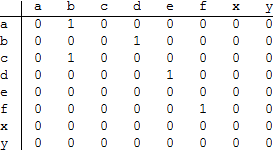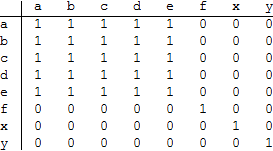I am trying to define some binary operators. A binary operator operates on a set of variables V and is defined by a subset S of pairs of those variables {Vi,Vj}. For example, "=",">",">=" are all binary operators that are already implemented in Mathematica. I would like to use Tilde[ ] as the "set" operator, analogous to "=" and TildeTilde[ ] as the test operator, analogous to "==". I will use a~~b here to represent TildeTilde[a,b]. I would like to be able to specify the operator as having any combination of three properties: Reflexive (x~~x is True for all x), symmetric (if x~~y then y~~x for all x,y) and transitive (if x~~y and y~~z then x~~z for all x,y,z). Perhaps I would specify other properties, and test various theorems on binary operators. The following code implements this in a very klugy way, but it works. I wonder if there is an elegant way of doing this? I looked at Can I define an axiomatic (Boolean algebra) system and prove theorems using Mathematica? and maybe I am asking too much.
The following code does what I want, but I am interested in a more elegant solution.
Tilde[a_, b_] := Module[{Change, SS},
If[Length[S] == 0, S = {{a, b}}, S = Append[S, {a, b}]];
If[Length[V] == 0, V = {a, b}, V = Union[Flatten[{V, a, b}]]];
SS = S;
Change = True;
While[Change, {
Change = False;
If[reflexive, SS = MakeReflexive[S]];
If[S != SS, Change = True];
S = SS;
If[symmetric, SS = MakeSymmetric[S]];
If[S != SS, Change = True];
S = SS;
If[transitive, SS = MakeTransitive[S]];
If[S != SS, Change = True];
S = SS;
}];
]
TildeTilde[a_, b_] := MemberQ[S, {a, b}]
MakeReflexive[S_] := Module[{n, nV, i, SS}, (* {a,a} True *)
SS = S;
n = Length[SS];
If[n > 0, {
nV = Length[V];
For[i = 1, i <= nV, i++, SS = Append[SS, {V[[i]], V[[i]]}]];
SS = Union[SS]; (* Remove duplicates *)
}];
SS
]
MakeSymmetric[S_] := Module[{n, i, SS}, (* {a,b} in S => {b,a} in S *)
SS = S;
n = Length[SS];
If[n > 0, {
For[i = 1, i <= n, i++, SS = Append[SS, {S[[i, 2]], S[[i, 1]]}]];
SS = Union[SS]; (* Remove duplicates *)
}];
SS
]
MakeTransitive[S_] := Module[{SS, n, i, j}, (* {a,c} in S and {c,b} in S => {a,b} in S *)
SS = S;
n = Length[SS];
If[n > 0, {
For[i = 1, i <= n, i++, {For[j = 1, j <= n, j++,
If[S[[i, 2]] == S[[j, 1]], SS = Append[SS, {S[[i, 1]], S[[j, 2]]}]];
]}];
SS = Union[SS]; (* Remove duplicates *)
}];
SS
]
STable[S_] := Module[{n, i, j, table}, (* Generate truth table for binary relation *)
n = Length[V];
table = Array["?" &, {n, n}];
For[i = 1, i <= n, i++, {For[j = 1, j <= n, j++, {
If[V[[i]] \[TildeTilde] V[[j]], table[[i, j]] = 1, table[[i, j]] = 0, table[[i,j]] = "?"];
}]}];
MatrixForm[table]
]
Now I can observe an equivalence truth table with:
ClearAll[a, b, c, d, e, f, x, y, S, V, reflexive, symmetric, transitive]
reflexive = True;
symmetric = True;
transitive = True;
V = {x, y}; (* include variables that might not be related to any other variable *)
a \[Tilde] b;
a \[Tilde] c;
d \[Tilde] e;
f \[Tilde] f;
Print["V=", V];
Print["S=", S];
STable[S]





make["transitive"]code but I wanted to get some ink on the page. I imagine it can be substantially optimized. $\endgroup$make["transitive"]would need to be performed last; sorry. The mechanism is pick a row then for every position at that row in which a1occurs select that row fromm. Total all selected rows (meaning add values down each column) and add this vector to the original row. Do this for every row inm, then repeat the processitimes to make sure any changes are propagated all the way acrossm. That last step is surely inefficient but I just wanted to get it done. $\endgroup$